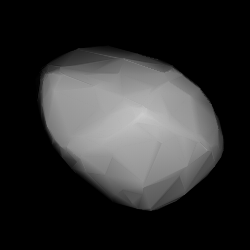Related Research Articles

Alkeste is a main-belt asteroid, and it is an S-type (silicaceous) in composition. C.H.F. Peters discovered the asteroid on August 23, 1872, from the observatory at Hamilton College, New York State. The name was chosen by Adelinde Weiss, wife of the astronomer Edmund Weiss, and refers to Alcestis, a woman in Greek mythology.

402 Chloë is a large main-belt asteroid. It was discovered by French astronomer Auguste Charlois on 21 March 1895 from Nice. This asteroid is orbiting the Sun at a distance of 2.56 AU with a period of 4.09 years and an eccentricity of 0.11. The orbital plane is inclined at an angle of 11.8° to the plane of the ecliptic.
Caprera is a minor planet orbiting the Sun.
Seppina is a minor planet orbiting the Sun.
Laodica is a minor planet orbiting the Sun.
Mabella is a minor planet orbiting the Sun.
Helga, provisional designation 1904 NC is a large main belt asteroid. It was discovered in 1904 by Max Wolf in Heidelberg. Helga is notable for being the first such object to be shown to be in a stable but chaotic orbit in resonance with Jupiter, its Lyapunov time being relatively short, at 6,900 yr. Despite this, its orbit appears to be stable, as the eccentricity and precession rates are such that it avoids close encounters with Jupiter. It forms part of the Cybele asteroid group.

Sara is a minor planet orbiting the Sun.

Nassovia is a minor planet orbiting the Sun. It is a member of the Koronis family of asteroids.

Charlotte is a minor planet orbiting the Sun. It was discovered by Paul Götz on September 11, 1904, in Heidelberg.
Irmgard is a minor planet orbiting the Sun.
Bandusia is a minor planet orbiting the Sun.

Musa is a minor planet orbiting the Sun.
Luisa is a minor planet orbiting the Sun.
625 Xenia is a minor planet orbiting the Sun. It was discovered by August Kopff in Heidelberg, Germany, on 11 February 1907. The name may have been inspired by the asteroid's provisional designation 1907 XN.
633 Zelima is a minor planet orbiting the Sun in the asteroid belt with a magnitude of 10.7. The name may have been inspired by the asteroid's provisional designation 1907 ZM.
635 Vundtia is a minor planet orbiting the Sun - though this claim has been disputed.
733 Mocia is a minor planet orbiting the Sun. A possible occultation was observed by Oscar Canales Moreno on October 1, 2001.
6144 Kondojiro (1994 EQ3) is an asteroid discovered on March 14, 1994 by Kin Endate and Kazuro Watanabe at the Kitami Observatory in eastern Hokkaidō, Japan. It is named after Jiro Kondo, a Japanese Egyptologist and professor of archaeology at Waseda University.
2021 LL37 is a large trans-Neptunian object in the scattered disc, around 600 kilometres (370 miles) in diameter. It was discovered on 12 June 2021, by American astronomers Scott Sheppard and Chad Trujillo using Cerro Tololo Inter-American Observatory's Dark Energy Camera in Chile, and announced on 31 May 2022. It was 73.9 astronomical units from the Sun when it was discovered, making it one of the most distant known Solar System objects from the Sun as of May 2022. It has been identified in precovery images from as far back as 28 April 2014.
References
- ↑ "569 Misa (1905 QT)". JPL Small-Body Database . NASA/Jet Propulsion Laboratory . Retrieved 5 May 2016.